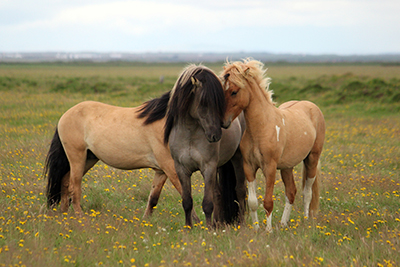Texas A&M Scientist Leads Study to Unlock Genetic Secrets of the Dun Coat in Horses
COLLEGE STATION, Texas – Today, horses come in a variety of coat colors, but most lack the camouflaging coat of their ancestors. However, a trace of that legacy remains in horses with the dun pattern, which characterized by pale hair covering most of the body, a dark stripe along the back, and zebra-like stripes on the legs. A recent study, published in Nature Genetics, reveals a new mechanism that explains the genetic roots of the dun pattern and uncovers why the pattern does not appear in most domesticated horses.

The study is the work of an international team of scientists, led by Texas A&M University Institute for Advanced Study (TIAS) scholar Dr. Leif Andersson and is the result of a collaboration between groups at Texas A&M University, Uppsala University in Uppsala, Sweden, and the HudsonAlpha Institute of Biotechnology in Huntsville, Alabama.
The dun pattern camouflaged ancient wild horses, protecting them from predators. However, domestic horses, like other domestic animals, have been selected over many generations to appear different from their wild counterparts. As a result of selective breeding, most domestic horses today are not dun and have coat colors that are more intensely pigmentation and uniformly distributed across the body.
“Dun is clearly one of the most interesting coat color variants in domestic animals because it does not just change the color but the color pattern,” Andersson stated. “We were really curious to understand the underlying molecular mechanism of why the dun pigment dilution does not affect all parts of the body.”
“Unlike the hair of most well-studied mammals, the dilute-colored hairs from dun horses are not evenly pigmented,” explained Freyja Imsland, a Ph.D. student in Andersson’s group. “They have a section of intense pigmentation along the length of the hair, on the side that faces out from the body of the horse, whilst the rest of the hair has more or less no pigment. The hairs from the dark areas of dun horses are in contrast intensely pigmented all around each individual hair. In spite of scientists having studied hair pigmentation in detail for a very long time, this kind of pigmentation is novel to science and quite unlike that seen in rodents, primates, and carnivores.”
Genetic analysis and DNA sequencing revealed that the dun color is determined by a single gene, which codes for the T-box 3 (TBX3) transcription factor. “Previous studies in humans and laboratory mice show that TBX3 controls several critical processes in development that affect bones, breast tissue, and cardiac conduction,” explained Dr. Greg Barsh, whose group at HudsonAlpha led the tissue analysis. “We were surprised to find that TBX3 also plays a critical role in skin and hair development.”
Researchers measured TBX3 distribution in individual hairs relative to other molecules known to regulate pigmentation. The researchers suggest that the signals governing where TBX3 is expressed could help to explain zebra stripes. In horses that have lost their dun color, TBX3 mutations do not inactivate TBX3 protein function and instead only affect where, both on the individual hair and on the horse’s body, the gene is expressed.
“In growing hairs, TBX3 mirrors the distribution of melanocytes, the cells that produce pigment,” explained Kelly McGowan, a senior scientist in Barsh’s lab. “Our results suggest that TBX3 affects differentiation of specific cells in the hair, creating a microenvironment that inhibits melanocytes from living in the ‘inner’ half of the hair.”
The team also discovered that there are two forms of dark, non-dun color: non-dun1 and non-dun2, which are caused by different mutations. Non-dun1 horses differ from dun horses in that they have a darker coat and less contrast between the stripes and the rest of the body. On the other hand, non-dun2 horses show no stripes at all.
“Non-dun horses have much more vibrant color than dun horses. Non-dun1 horses tend to show primitive markings similar to dun horses, whereas non-dun2 horses generally don’t show primitive markings,” Imsland stated. “These primitive markings in non-dun1 horses can sometimes lead horse owners to think that their intensely pigmented non-dun1 horses are dun.”
The study indicates that the non-dun2 variant occurred recently-most likely after domestication. In contrast, the dun and non-dun1 variants predate domestication. Evidence of this conclusion can be found in the DNA of a horse that lived about 43,000 years ago, long before horses were domesticated, which carried both dun and non-dun1 variants.
“This demonstrates that horse domestication involved two different color morphs-dun and non-dun1-and future studies of ancient DNA will be able to reveal the geographic distribution and the abundance of the two morphs,” Andersson said.


